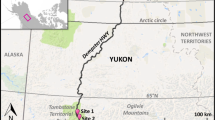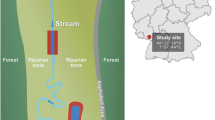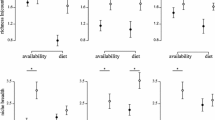Summary
To determine the effect of lizards on webspider populations, we conducted a long-term field experiment in the Bahamas. Numbers of spider individuals were about 3 times higher in lizard-removal enclosures than in control enclosures with natural densities of lizards. Dietary analyses showed that lizards ate spiders and that lizard and spider diets overlapped substantially. Lizards reduced biomass of prey consumed by spiders; details indicated that they reduced biomass of large (> 4 mm) prey consumed by spiders more than biomass of small (≤4 mm) prey. Similarly, lizards reduced biomass of large aerial arthropods caught in sticky traps but not biomass of small aerial arthropods. We found no evidence that the lizard effect on prey consumption by spiders was caused by a spatial shift from areas with high aerial arthropod abundance to areas with low aerial arthropod abundance. Lizards reduced adult female cephalothorax width and fecundity of spiders. In a separate experiment, food-supplemented spiders were more fecund than control spiders. This study indicates that the interaction between lizards and spiders includes both predation and competition for food.
Similar content being viewed by others
References
Abrams PA (1987) On classifying interactions between populations. Oecologia 73:272–281
Anderson JF (1974) Responses to starvation in the spiders Lycosa lenta Hentz and Filistrata hibernalis (Hentz). Ecology 55:576–585
Bender EA, Case TC, Gilpin ME (1984) Perturbation experiments in community ecology: theory and practice. Ecology 65:1–13
Connell JH (1983) On the prevalence and relative importance of interspecific competition: evidence from field experiments. Am Nat 122:661–696
Floyd HB, Jenssen TA (1983) Food habits of the Jamaican lizard Anolis opalinus: resource partitioning and seasonal effects examinined. Copeia 1983:319–331
Freund RJ, Littell RC (1981) SAS for linear models. SAS Institute Inc, Cary, NC
Greenstone MH (1978) The numerical response to prey availability of Pardosa ramulosa (McCook) (Araneae: Lycosidae) and its relationship to the role of spiders in the balance of nature. Sym Zool Soc Lond 42:183–193
Holt RD (1977) Predation, apparent competition, and the structure of prey communities. Theor Popul Biol 12:197–229
Holt RD (1984) Spatial heterogeneity, indirect interactions, and the coexistence of prey species. Am Nat 124:377–406
Kessler A (1973) A comparative study of the production of eggs in eight Pardosa species in the field (Araneae, Lycosidae). Tijdschrift Entomol 116:23–41
Kerfoot CW, Sih A (1987) Predation: direct and indirect impacts on aquatic communities. University Press of New England, Hanover, NH
Miller RG Jr (1981) Simultaneous statistical inference, second edition. Springer-Verlag, New York
Mittelbach GG, Chesson PL (1987) Predation risk: indirect effects on fish populations. In: Kerfoot CW, Sih A (eds) Predation: direct and indirect impacts on aquatic communities. University Press of New England, Hanover, NH, pp 315–332
Neter J, Wasserman W, Kutner MH (1985) Applied linear statistical models. Irwin, Homewood, Il.
Netwig W (1980) The selective prey of linyphiid-like spiders and of their space webs. Oecologia (Berlin) 45:236–240
Olive CW (1980) Foraging specializations in orb-weaving spiders. Ecology 61:1133–1144
Pacala S, Roughgarden J (1984) Control of arthropod abundance by Anolis lizards on St. Eustatius (Neth. Antilles). Oecologia (Berlin) 64:160–162
Pacala S, Rummel J, Roughgarden J (1983) A technique for enclosing Anolis lizard populations under field conditions. J Herpetology 17:94–97
Peterson CH, Andre SV (1980) An experimental analysis of interspecific competition among marine filter feeders in a soft-sediment environment. Ecology 61:129–139
Polis GA, Myers CA, Holt RD (1989) The ecology and evolution of intraguild predation: potential competitors that eat each other. Ann Rev Ecol Syst 20:297–330
Riechert SE, Luczak J (1982) Spider foraging: behavioral responses to prey. In: Witt RN, Rovner JS (eds) Spider communication: mechanisms and ecological significance. Princeton University Press, Princeton, pp 353–385
Riechert SE, Tracy CR (1975) Thermal balance and prey availability: bases for a model relating web-site characteristics to spider reproductive success. Ecology 56:265–284
Schoener TW (1967) The ecological significance of sexual dimorphism in size in the lizard Anolis conspersus. Science 155:474–477
Schoener TW (1968) The Anolis lizards of Bimini: resource partitioning in a complex fauna. Ecology 49:704–726
Schoener TW (1974) Some methods for calculating competition coefficients from resource-utilization spectra. Am Nat 108:332–340
Schoener TW (1980) Length-weight regressions in tropical and temperate forest-understory insects. Ann Entomol Soc Am 73:106–109
Schoener TW (1983) Field experiments on interspecific competition. Am Nat 122:240–285
Schoener TW (1986) Patterns in terrestrial vertebrate versus arthropod communities: do systematic differences in regularity exist? In: Diamond J, Case TJ (eds) Community ecology. Harper & Row, New York, pp 556–586
Schoener TW (1989) Should hindgut contents be included in lizard dietary compilations? J Herpetology 23:455–458
Schoener TW, Gorman GC (1968) Some niche differences among three species of Lesser Antillean anoles. Ecology 49:819–830
Schoener TW, Spiller DA (1987) Effect of lizards on spider populations: manipulative reconstruction of a natural experiment. Science 236:949–952
Schoener TW, Toft CA (1983a) Dispersion of a small-island population of the spider Metepeira datona (Araneae: Araneidae) in relation to web-site availability. Behav Ecol Sociobiol 12:121–128
Schoener TW, Toft CA (1983b) Spider populations: extraordinarily high densities on islands without top predators. Science 219:1353–1355
Sih A, Crowley P, McPeek M, Petranka J, Strohmeier K (1985) Predation, competition, and prey communities: a review of field experiments. Ann Rev Ecol Syst 16:269–311
Sih A, Petranka JW, Kats LB (1988) The dynamics of prey refuge use: a model and tests with sunfish and salamander larvae. Am Nat 132:463–483
Sokal RR, Rohlf FJ (1981) Biometry, second edition. W.H. Freeman, San Francisco
Smith DRR (1983) Ecological costs and benefits of communal behavior in a presocial spider. Behav Ecol Sociobiol 13:107–114
Spiller DA (1984a) Competition between two spider species: experimental field study. Ecology 65:909–919
Spiller DA (1984b) Seasonal reversal of competitive advantage between two spider species. Oecologia 64:322–331
Spiller DA, Schoener TW (1988) An experimental study of the effect of lizards on web-spider communities. Ecol Monogr 58:57–77
Spiller DA, Schoener TW (1989) Effect of a major predator on grouping of an orb-weaving spider. J Anim Ecol 58:509–523
Stevens J (1986) Applied multivariate statistics for the social sciences. Lawrence Berlbaum Associates, Hillsdale, NJ
Toft CA, Schoener TW (1983) Abundance and diversity of orb spiders on 106 Bahamian islands: biogeography at an intermediate trophic level. Oikos 41:411–426
Turnbull AL (1962) Quantitative studies of the food of Linyphia triangularis Clerck (Araneae: Linyphiidae). Can Entomol 94:1233–1249
Turnbull AL (1973) Ecology of true spiders (Araneomorphae). Ann Rev Entomol 18:305–348
Van Wingerden WKRE (1978) Population dynamics of Erigone arctica (White) (Araneae, Linyphiidae). II. Symp Zool Soc Lond 42:195–202
Werner EE (1986) Species interactions in freshwater fish communities. In: Diamond J, Case TJ (eds) Community ecology. Harper & Row, New York, pp 344–358
Werner EE, Gilliam JF (1984) The ontogenetic niche and species interactions in size-structured populations. Ann Rev Ecol Syst 15:393–425
Wilbur HM (1984) Complex life cycles and community organization in amphibians. In: Price PW, Slobodchikoff CN, Gaud WS (eds) A new ecology: novel approaches to interactive systems. Wiley, New York, pp 195–224
Wise DH (1975) Food limitation of the spider Linyphia marginata: experimental field studies. Ecology 56:637–646
Wise DH (1979) Effects of experimental increase in prey abundance upon female reproductive rates of two orb-weaving spider species. Oecologia 41:289–300
Wise DH (1981) Inter- and intraspecific effects of density manipulations upon females of two orb-weaving spiders (Araneae: Araneidae). Oecologia 48:252–256
Author information
Authors and Affiliations
Rights and permissions
About this article
Cite this article
Spiller, D.A., Schoener, T.W. Lizards reduce food consumption by spiders: mechanisms and consequences. Oecologia 83, 150–161 (1990). https://doi.org/10.1007/BF00317746
Received:
Accepted:
Issue Date:
DOI: https://doi.org/10.1007/BF00317746




